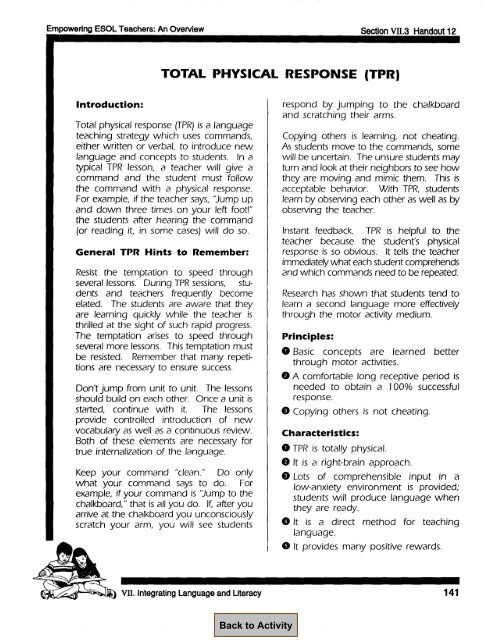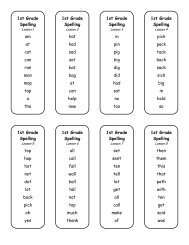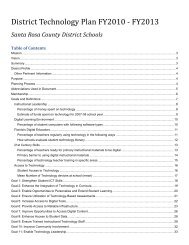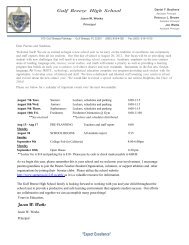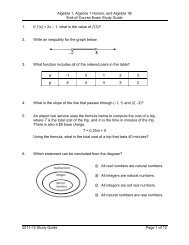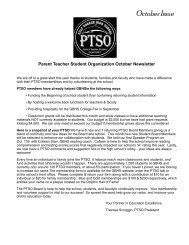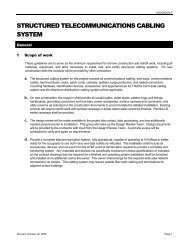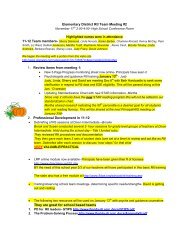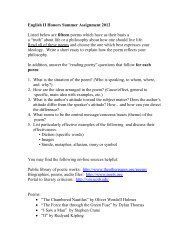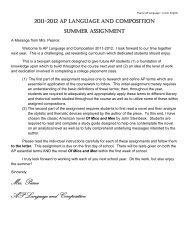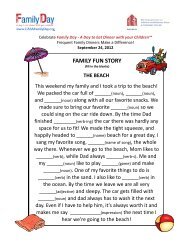Total Physical Response (TPR) (VII HO12)
Total Physical Response (TPR) (VII HO12)
Total Physical Response (TPR) (VII HO12)
You also want an ePaper? Increase the reach of your titles
YUMPU automatically turns print PDFs into web optimized ePapers that Google loves.
TOTAL PHYSICAL RESPONSE (<strong>TPR</strong>)<br />
Introduction:<br />
<strong>Total</strong> physical response (<strong>TPR</strong>) is a language<br />
teaching strategy which uses commands,<br />
either written or verbal, to introduce new<br />
language and concepts to students. In a<br />
typical <strong>TPR</strong> lesson, a teacher will give a<br />
command and the student must follow<br />
the command with a physical response.<br />
For example, if the teacher says, ‘Jump up<br />
and down three times on your left foot!”<br />
the students after hearing the command<br />
(or reading it, in some cases) will do so.<br />
General <strong>TPR</strong> Hints to Remember:<br />
Resist the temptation to speed through<br />
several lessons. During <strong>TPR</strong> sessions, students<br />
and teachers frequently become<br />
elated. The students are aware that they<br />
are learning quickly while the teacher is<br />
thrilled at the sight of such rapid progress.<br />
The temptation arises to speed through<br />
several more lessons. This temptation must<br />
be resisted. Remember that many repetitions<br />
are necessary to ensure success.<br />
Don’t jump from unit to unit. The lessons<br />
should build on each other. Once a unit is<br />
started, continue with it. The lessons<br />
provide controlled introduction of new<br />
vocabulary as well as a continuous review.<br />
Both of these elements are necessary for<br />
true internalization of the language.<br />
Keep your command “clean.” Do only<br />
what your command says to do. For<br />
example, if your command is ‘~ump to the<br />
chalkboard, ” that is all you do. If, after you<br />
arrive at the chalkboard you unconsciously<br />
scratch your arm, you will see students<br />
respond by jumping to the chalkboard<br />
and scratching their arms.<br />
Copying others is learning, not cheating.<br />
As students move to the commands, some<br />
will be uncertain. The unsure students may<br />
turn and look at their neighbors to see how<br />
they are moving and mimic them. This is<br />
acceptable behavior. With <strong>TPR</strong>, students<br />
learn by observing each other as well as by<br />
observing the teacher.<br />
Instant feedback. <strong>TPR</strong> is helpful to the<br />
teacher because the student’s physical<br />
response is so obvious. It tells the teacher<br />
immediatelywhat eachstudent comprehends<br />
and which commands need to be repeated.<br />
Research has shown that students tend to<br />
learn a second language more effectively<br />
through the motor activi~ medium.<br />
Principles:<br />
O Basic concepts are learned better<br />
through motor activities.<br />
~ A comfortable long receptive period is<br />
needed to obtain a 100% successful<br />
response.<br />
~ Copying others is not cheating.<br />
Characteristics:<br />
O <strong>TPR</strong><br />
is totally physical.<br />
~ It is a right-brain approach.<br />
~ Lots of comprehensible input in a<br />
low-anxiety environment is provided;<br />
students will produce language when<br />
they are ready.<br />
@ It is a direct method for teaching<br />
language.<br />
0 It provides many positive rewards.<br />
<strong>VII</strong>. Integrating Language and Literacy 141
Section <strong>VII</strong>-3 Handout 12 Em~owerina ESOL Teachers: An Overview<br />
@ It deals with<br />
real-life situations.<br />
@ It gives instant feed-back to the teacher.<br />
~ k starts with the imperative.<br />
Strengths:<br />
O Provides a low affective filter.<br />
~ High motivational level.<br />
0 High retention.<br />
@ Good for non-native English students<br />
@ Immediate knowledge of results.<br />
~ Useful with all age levels.<br />
0 Very flexible.<br />
~ Consistent with other natural approaches.<br />
References:<br />
Asher, J. (1988). Learning another<br />
language through actions: The complete<br />
teacher> guidebook. Los Gates,<br />
CA: Sky Oaks Productions, Inc.<br />
Law, B. & Eckes, M. (1990). The more<br />
than just surviving handbook. E5L for<br />
every c/assroom teacher. Winnipeg,<br />
CANADA: Peguis Publishers Limited.<br />
McCloskey, M. L. (1990j. Integrated<br />
language teaching strategies and inte<br />
grated thematic units. Atlanta, GA:<br />
Educo Press.<br />
Illustrations of <strong>Total</strong> <strong>Physical</strong><br />
<strong>Response</strong> Activities:<br />
The Pointing<br />
Game<br />
With a small group of students, use a<br />
collection of pictures such as those one<br />
might find in a mail order catalog to<br />
reinforce concepts that have been taught.<br />
Ask students to point to various specific<br />
body parts (a head, an arm), to colors<br />
(something green~, or to items of clothing<br />
(a dress, a sweater).<br />
Identifying<br />
Emotions<br />
After the class has acquired simple<br />
commands such as “cry” or “laugh,”<br />
pictures can be placed across the front of<br />
the room of people clearly demonstrating<br />
such emotional reactions. Students can<br />
be asked to take the picture of a person<br />
displaying a specific reaction (someone<br />
crying, someone laughing). Later this<br />
same procedure can be extended to<br />
other kinds of descriptions of emotions,<br />
perhaps more subtle ones [someone who<br />
is sad, someone who is angry).<br />
Dress the Paper Doll<br />
A large paper doll man, woman, or child<br />
with a set of clothes can be made and<br />
mounted on a bulletin board. Velcro can<br />
be used to make the paper clothes stick<br />
to the figure. Students are then asked to<br />
place various items of clothing on it.<br />
Concepts such as checked, polka dotted,<br />
and striped can be taught in the same<br />
manner along with a variety of fabrics<br />
and textures, different kinds of materials<br />
can be cut in the shape of the paper<br />
clothes and glued to them.<br />
Manipulating<br />
Rods<br />
Rods of various colors such as those used<br />
in Gattegno’s Silent Way can provide<br />
realia for teaching numbers, spatial relationships,<br />
colors, and the like (take the<br />
b/ue rod, take three red rods, put the<br />
blue rod beside the red rod and give it to<br />
the teacher].<br />
142 <strong>VII</strong>.Integrating Language and Literacy
Empowering ESOL Teachers: An Overview Section V.U.3 Handout 12<br />
Working<br />
with Shapes<br />
Another idea is to cut squares, rectangles,<br />
triangles, and circles out of various colors<br />
of construction paper and distribute them<br />
to the students. Shapes (hold up the<br />
triangle), colors (hold up the green<br />
triangle), and numbers (hold up three<br />
triangles) can be taught or reinforced.<br />
Ordinal numbers can also be introduced<br />
by placing several shapes in various<br />
positions along the chalkboard. A student<br />
can be asked to place the green<br />
triangle in the third position or the eighth<br />
position. For example, each student in<br />
the class can then be given a small box of<br />
crayons or colored pencils and a handout<br />
with rows of squares, rectangles, triangles,<br />
and circles drawn on it. Commands<br />
such as “Find the first row of<br />
circles. Go to the fifth circle, Color it red”<br />
can be given to reinforce not only the<br />
shape, but the ordinal number and the<br />
color.<br />
written recipe. An extra large version to<br />
which you and the students can refer can<br />
be placed at the front of the room. While<br />
you or a student reads the recipe, other<br />
students can measure, mix the ingredients,<br />
and so on. As a follow-up, students<br />
can bring in favorite recipes to share,<br />
These can be put together to form a class<br />
recipe book to which others can be<br />
added.<br />
As a follow-up, students can cut out of<br />
old magazines pictures of objects that<br />
have shapes similar to those mentioned<br />
above. Another follow-up might be to<br />
have students cut the various shapes<br />
from colored poster board, newsprint,<br />
or wallpaper. Have them arrange the<br />
shapes into a collage.<br />
Following<br />
Recipes<br />
At much later stages, making holiday rice<br />
cakes, baking valentine cookies, or<br />
preparing enchiladas can provide a <strong>TPR</strong><br />
experience and can also involve students<br />
in the cultures of other countries and<br />
those within the United States. First<br />
display all the ingredients for any given<br />
recipe and introduce each item, one by<br />
one. Then present each student with a<br />
Excerpted frem:<br />
Richard-Amato, P. A. (1988). Making it happen:<br />
Interaction in the second language classroom-<br />
- from theory to practice, White Plains, NY<br />
Longmans, Inc., pp. 76-78 Reprinted with<br />
permission.<br />
<strong>VII</strong>. Integrating Language and Literacy 143


